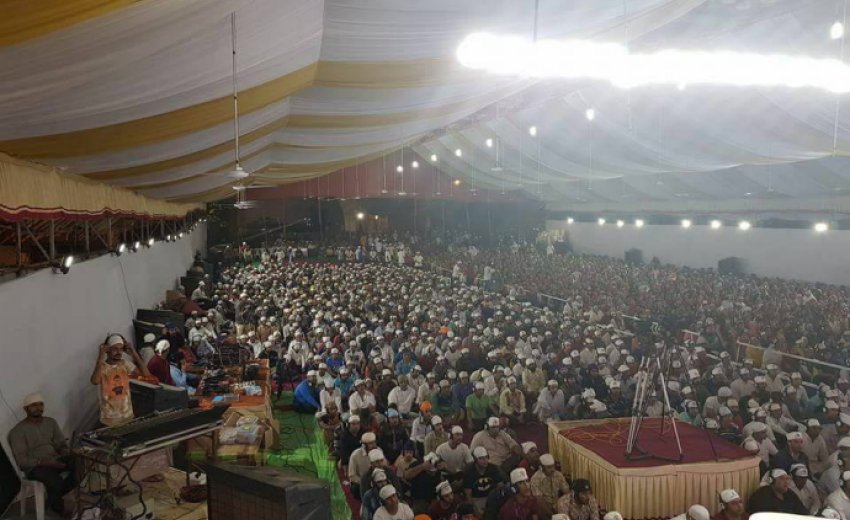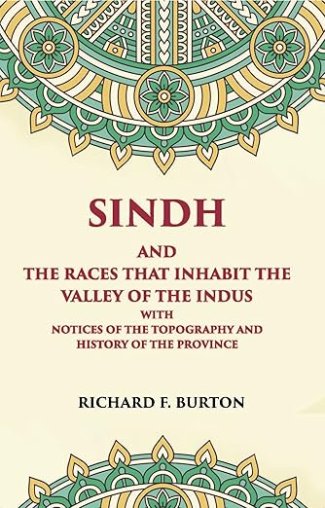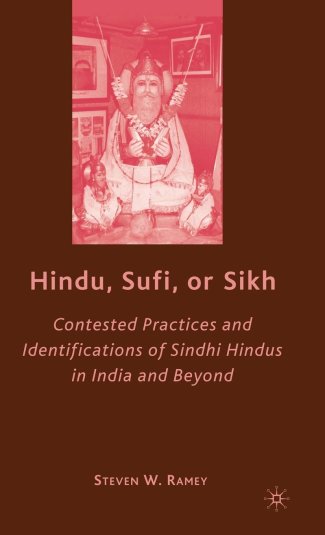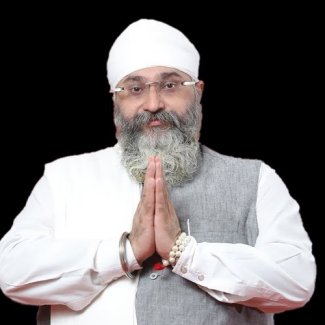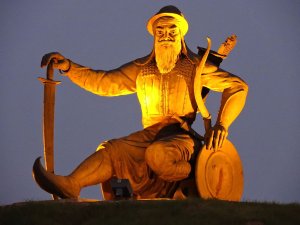Introduction
The recent incident of 13 years old Sindhi girl dressed up as Guru Nanak Sahib in a hall of a Tikana Sahib (Sindhi Hindu Temple) again exposes the lack of knowledge and understanding amongst the Sindhi Hindus regarding the Sikh Rehat Maryada (Sikh code of conduct or Sikh way of life). Almost 2 years ago, more than 100 Birs of Guru Granth Sahib were given up by the Sindhi community. One would have hoped that the incident would have prompted a response to educate the Guru Nanak Naam Leva communities. It seems very little has been done to indoctrinate the basic Sikh code of conduct among Sindhis. The article will try to understand the heterodox beliefs of Sindhis and their misrepresentation as Sahajdhari Sikhs. The Sindhi in the article refers to the Sindhi Hindu in India.
Sindhis & their Faith – 1851
The British annexed Sindh in 1843 and found Sindh unique and different from other Indian provinces. Sir Richard F Burton (1851) wrote Sindh & the races that inhabit the Valley of the Indus describe a curious mix of Hindu and Sikh practices among Sindhi Hindus. He calls them ‘heterodox Sikhs’ and observed that “they show a general tendency towards the faith of Nanak Shah, and that many castes have so intermingled the religion of the Sikh with their original Hinduism, that we can scarcely discern the line of demarcation.”
Burton adds that there is no remnant of the Kshatriya (warrior caste) in Sindh, “Those who lay claim to the regal origin are generally Banyans (Baniyas, the trader/mercantile community) who have partly conformed to the practice of Nanak Shah’s religion, they are therefore heterodox Sikhs. Their chief occupations are trade and government employment. Their studies are confined to the writings of the Gurus, and sufficient Persian to keep them in office. They wear no peculiar costumes and do not necessarily shave their beard. Their food is the same as that of Sarswat Brahmans, except that they eat only animals that have been killed, either by themselves or a fellow caste man, according to the Sikh rite termed Jhatko. Finally, they are either pure theist (belief in the existence of God), or as is more generally the case, they mix up deism (rationalism) with the old idolatry of the Hindoos.”
Burton states that Lohano Sikh is called Nanak Shahi and Munnee Singh (a Shaver). Sometimes he wears a kara but never the Chakkar. Lohana is a caste from a trading community. The writer mentions Udasi priests and their initiation of people into the Nanak Shahi faith. He adds that these people recited Jap Ji Sahib, Rehras Sahib and Sukhmani Sahib. The author of this article could not find an older resource on the faith of Sindhi Hindus.
Are Sindhi Hindus or Sikhs?
In 2008 Professor Steven Ramey of the University of Alabama, USA wrote a fascinating book on Sindhis titled Hindu Sufi or Sikh: Contested Practices and Identifications of Sindhi Hindus in India
and Beyond. The book discusses the heterodox beliefs and rituals of the Sindhis who follow both Hindu and Sikh tenets. To understand Sindhis, one must set aside their standards and preconceived ideas about what constitutes a Hindu, Sikh, and even Muslim religion. As per the 2011 Census, there were 2.77 million Sindhi speakers in India. Further 1.74 million spoke Sindhi as a second language.
The Sindhi Sangat in India can be divided into the following groups based on the author’s study of Sindhis for the past 10 years:
- Sindhi Sikhs – These are the Keshadhari Sikhs from the
province of Sindh who migrated to India in 1947 following the country’s partition. They are practicing Sikhs, and many share the surnames with the Punjabi Arora community. Curiously the Arora community traces their origin from Aror (now called Rohri) in North Sindh. There are about 90,000 – 1 lakh Sindhi Sikhs who live like Sindhi Hindus in the states of Rajasthan, Madhya Pradesh, Maharashtra, and Gujarat. They can play a vital role in linking with Sindhi as predominately mainstream Sikhs from Punjab have little and or clue about the Sindhis.
- Sindhi Sahajdhari – About 10% of the Sindhis in India are very close to Sikhi, their birth, happiness, marriage, and death everything is done as per the Sikh traditions and in the Gurdwara Sahibs. They are Sahajdhari Sikhs, and they will get offended if a Punjabi Sikh doubts their devotion or credentials as a Sikh. Curiously most of this group, perhaps out of ignorance, continue to put themselves as Hindus in the population census and other government documents.
- Sindhi– It is problematic to give a name to this group. They constitute more than 50% of all Sindhis in India. Their beliefs and way of life have Hindu and Sikh overlap to varying degrees. Guru Nanak Dev Ji and Sukhmani Sahib, the composition of Guru Arjan Dev Ji hold a very important place in their faith. Every happy occasion means shukrana (thanks) and langar in the Gurdwara or reciting Sukhmani Sahib in the presence of Guru Granth Sahib.
Post partition the reverence for Sain Jhule Lal has grown. In 1950 Sindhis, led by Ram Panjwani in Bombay, declared Jhulelal as the icon of unity for all Sindhis. These people were most probably brought closer to Sikhi by the Udasi Mahants. Many hold Baba Sri Chand the founder of the Udasi sect in high esteem. They may go to mainstream Hindu Temples as well. Many would have marriages through Anand Karaj but many who have Hindu Agni pheras would have Akhand Paathh or Sahaj Paathh (reading of full Guru Granth Sahib) first.
- Sindhi Hindus – About 1/3 of Sindhi have little or no relations with Sikhi now. These people just know the name of Guru Nanak Sahib. He is one of the many deities for them. There may also be following a living Guru who heads a Dera. This could be post-partition change in these people. The lack of engagement from Sikhs, geographical distance from Punjab, and eagerness to adopt the local culture of the majority community seem to have contributed to this switch in the doctrine. The substantial number of Sindhis in Gujarat are now vegetarians, unlike their ancestors who came from Sindh.
Episode in Indore – January 2023
The Sindhis (mostly from the above group 4) gave up Guru Granth Sahib in Indore in January 2023. It all started with Nihang Singhs alleging that the sanctity of Guru Granth Sahib was not being maintained in the Deras and Temples. They also demanded the removal of Hindu deity idols that were placed alongside Guru Granth Sahib in these Temples. The Parkash (ceremonial opening at dawn) and Sukhasan (ceremonial closing at night) of Guru Granth Sahib were not done in many of these places, sometimes out of ignorance. In most places, they had none or very few people who could read the Gurmukhi script. They should have been given the Sanchian (small booklets) of Guru Granth Sahib. The Sanchian is Guru Granth Sahib in 2 or more parts. Although proper respect must be given to Sanchian, there is no obligation to perform their daily Parkash and Sukhasan.
Other communities with shared Hindu-Sikh Beliefs
A Hindu Arora living in Haryana shared this incident. His grandparents came from Lyallpur, Pakistan. About 25 years ago they (grandparents) had arranged some Pooja at home. The Pandit who was doing the ritual prayer just before the finish asked them (grandparents) about their Isht devta. After contemplating for a few seconds, the grandfather said Guru Nanak Dev Ji. The Pandit who was also from Lyallpur also felt it was the right answer. And they continued with the Pooja.
The interviewee’s marriage was conducted by Hindu Agni pheras but they did Akhand Pathh at home before the wedding. He tells me his mother does Japji Sahib in the morning and Rehras Sahib in the evening and the rest of the family joins her.
The Hindu Aroras from Multan, Bahawalpur, and South Punjab are now settled in Rajpura (district Patiala) and many of them have dual Sikh – Hindu beliefs to varying degrees. Interestingly due to their ancestors’ geographical proximity to Sindh, the worship of Sain Jhule Lal is also observed by some.
Impersonation of Guru Nanak Dev Ji by a Sindhi girl
The video of a 13-year-old Sindhi girl dressed up as Guru Nanak Dev Ji on Gurpurab in a hall of a Thikana (Sindhi Temple) in Shahdol, Madhya Pradesh went viral. It was wrong and unfortunate that the elders of the community out of ignorance of Maryada permitted her to dress up as Guru Sahib. The 13-year-old Sindhi girl out of devotional love felt that her Guru Sahib had been left out as other kids were getting dressed up as Shivji, Ganeshji, and other Hindu deities.
The mainstream Sikh community needs to share some part of the blame that they have not been able to tell the Maryada to Guru Nanak Naam Leva Sangat outside Punjab. Most Punjabi Sikhs who have not interacted or lived with Sindhi Hindus have no clue about their devotion to Guru Nanak Sahib and Gurbani (especially Sukhmani Sahib) started commenting adversely on the social media. Even death threats were given to the family. Despite multiple apologies from the girl and her parents, they have been dubbed RSS agents. The RSS and SGPC came into existence in the 1920s but Sindhi Hindus have been a follower of Guru Nanak Sahib since 1521 when Guru Sahib visited Sindh.
The poor girl has been hospitalised for acute depression. She was seen shivering with fear in a video. It was not a pleasant sight. The matter should have been left in the hands of Sikhs living in Madhya Pradesh, Gujarat, and Maharashtra who know them well. There are many Khalsa Sikhs amongst Sindhis as well.
Difference in Behaviour
Punjabis are large-hearted but also emotional. Sadly, some of the present generation have this notion that they know all. The Sikhs in Nankana Sahib are originally from the FATA region of the KPK province (previously known as NWFP). The elders speak Pashto, but their new generation is fluent in both Punjabi and Pashto. All these Sikhs are Keshadhari, and many are Amritdhari as well. During their visit of the Jathas from India, there will always be some Punjabi Sikh with trimmed beards and wearing a turban without unshaven Kesh would have the audacity to comment “What kind of Sikhs are these, who can’t speak Punjabi?”
Bhai Gurpreet Singh (popularly known as Rinku Veerji) of Amritvela Trust, Ulhasnagar has a huge following amongst the Sindhis, but a few Sikhs are unhappy that his Katha is done in Hindi rather than Punjabi. The Guru Nanak Naam Leva Sangat are mostly non- Punjabi hence it makes perfect sense to communicate with them in the language they understand. This regional-centric approach will not help Sikhi in the long run.
A Sahajdhari Sikh from Khost (province in Afghanistan) was building a Gurdwara Sahib in London. A group of Punjabi Sikhs demanded to know from him, why a Hindu was building a Gurdwara Sahib. The poor chap was cross-questioned many times. Unlike Punjabis, these people and Sindhis are non-confrontational and would avoid any dispute at all costs. Some elements of their communities tell them that they are not considered Sikhs (by mainstream Punjabi Sikhs) and that they should leave Sikhi. Why are we not learning about these people?
In Baluchistan (Pakistan) the Nanakpanthis and Hindus in Baluchistan have Gurdwara Sahib and Mandir in different buildings or rooms (with separate entrances) but in the same premises. This has been done in line with the wishes of the Sahajdhari Sangat to adhere to the Rehat Maryada. The Keshdhari Sikh Sangat are only a handful, but the Hindus are 0.5% of the total population. The province is sparingly populated with only an average of 12 people per square
kilometre. The arrangement maintains the security and optimum utilization of manpower and monetary resources. This is something for Sindhis and Sikhs to learn from this micro-minority.
Conclusion
It is imperative that we understand the present-day Sindhis as they are part of the wider Sikh family. Equally crucial is that we don’t dub all Sindhis as Sahajdhari and then do not do any parchaar of Sikhi amongst them. The Banjaras are a nomadic community found mostly in Maharashtra, Karnataka, and Andhra Pradesh and number about 10-12 crore. S.G. Deogaonkar (1992) wrote that the so-called Sikh Banjara revere Guru Nanak Sahib but have no ritual or observance except tying of a rupee in the turban of the bridegroom in the honour of Guru Sahib, which is spent for the distribution of sweets after the marriage. In these Banjaras, there is an integration of traditional Hindu worship with the worship of Guru Nanak Sahib. Many academics from Punjab continue to state that there are 12 crore Banjara Sahajdhari Sikhs in India. This information has steered to the misleading belief that they are fully conversant with Sikhi and hence mainstream Sikhs from Punjab are not sending any Jathas in their areas to preach the philosophy of Gurbani.
The author feels it is not his place or anyone to say who is not a Sikh. This is for an individual to decide. The heterodox belief is not limited to Sindhis. All Hindus who lived in the region now called Pakistan and even Afghanistan have an overlap with Sikhi.The Gurdwara Sahibs built in Russia, Mauritius, Gibraltar, Malta, Nigeria, Thailand, Singapore, Dubai, Malaysia, and other South East Asian countries have substantial monetary contributions from the Sindhi community. The Punjabi mainstream Sikhs cannot turn a blind eye to the devotion and love of Sindhis towards the Guru Sahibans.
Sindhis sometimes get criticised by both Hindu and Sikh extreme elements for their heterodox beliefs. The actions in Indore in January 2023 and now in Shahdol in November 2024 will push the Sindhi and other Sahajdhari communities away from Sikhi. After incidents such
as this, they will be scared to associate themselves with Sikhi-related traditions. Already there are some Sindhis and many Hindus from Frontier province who would say that unlike them, their grandparents would read Gurbani and visit Gurdwara Sahibs. Let us not be a silent spectators on the issue. Let SGPC and other Sikhs Institutions make concerted efforts to propage basic Sikh tenets and Sikh practices among the Sindhis through the publication of small tracts and Sindhi speaking Sikh preachers.
~~~ BIBLIOGRAPHY
Richard Burton(1851) Sindh & the races that inhabit the Valley of the Indus with notices of the topography and history of the province. London: W.H. Allen & Co.
Steven Ramey (2008) Hindu, Sufi, or Sikh Contested Practices and Identifications of Sindhi Hindus in India and Beyond. New Delhi: Palgrave Macmillan
Inderjeet Singh (2017) Sindhi Hindus & Nanakpanthis in Pakistan. Abstracts of Sikh Studies, Vol. XIX, No.4. p35-43 Inderjeet Singh (2020) Sikhi & Sindhi Hindus -The History & Overlap. Abstracts of Sikh Studies. 2020, Vol XXII, Issue 3, p38-47
S.G. Deogaonkar & Shailaja S. Deogaonkar (1992) The Banjaras. New Delhi: Concept
Originally published in Abstracts of Sikh Studies Jan - Mar 2025 Journal.
